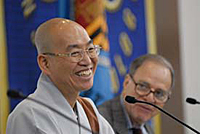 Inside North Korea: A Report by Good Friends Chairman Venerable Pomnyun and Seungjoo Baek
Inside North Korea: A Report by Good Friends Chairman Venerable Pomnyun and Seungjoo Baek
SAIS US Korea Institute
September 19, 2007
Chairman of the Good Friends Center for Peace, Human Rights and Refugees, the Venerable Pomnyun, briefed audience members at SAIS on current trends inside North Korea, including issues surrounding the current food crisis caused by the flooding, continuing health crisis, and the breakdown of the education system.
Good Friends, one of the largest Korea-based organizations providing humanitarian aid inside the D.P.R.K. and to refugees in Northern China, contributes some of the most accurate and timely reports on conditions inside North Korea. The Venerable Pomnyun visited Washington D.C. with a team of experts to discuss the on-going food shortage and proliferation of non-government controlled information. While here, they briefed Congress and held a day-long conference at CSIS.
Highlights of his comments (paraphrased, not direct quotes):
- In contrast to the much lower number of famine deaths provided by Stephan Haggard and Marcus Noland Pomnyun maintained the 3 million number claimed by Good Friends in the past.
- He provided a short narrative of coping mechanisms people have adopted to stay afloat (selling and manufacturing in homes). Society is being sustained by activities that are still considered illegal.
- He claims the food situation is getting worse, and he does not think the DPRK can resolve the situation on its own. Now people buy all their food on the market.
- He claims that people’s lives are not improving.
- TB is on the increase along with other epidemics. Since there is no electricity, water is not clean.
- He offered that there are four levels of hospitals: clinics at the town level, hospitals in cities and some towns, hospitals at province level, and specialist offices in the Pyongyang area.
- Hospitals and clinics are not working at the city/province level. The situation is better in Pyongyang hospitals. The amount of international medical aid, however, is not enough for even the Pyongyang hospitals.
- Medical aid is the second most needed good (after food). People do not get medicines from the hospital, but from the markets. With low salaries, however, medicines are difficult to afford. [Because the institutional environment is still not supportive of entrepreneurship] there are qulaity problems with pharmaceuticals purchased at the markets.
- The education system, though ‘free’ is not functioning well. Due to the food shortage problem, students do not go to school. Teachers also do not come to class. The cost of education is being pushed back to students directly. For example, students buy chalk for teachers. As a result, however, poor students cannot attend school. The rich students are hiring tutors, so we are seeing a market in private education emerge in the DPRK.
- The DPRK is slowly moving to a private economic system. Men who cannot get work are now jokingly referring to themselves as “guard dogs,” because they sit at home all day.
- North Koreans do not trust the government or party. People on their death beds are telling their children to trust their descendents, not the government. People still spend much of their time trying to subsist, but these complaints will not become a political issue. The political system is stable and will not collapse any time soon.


